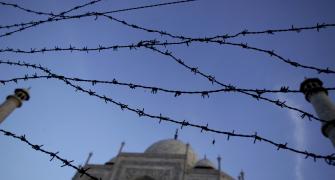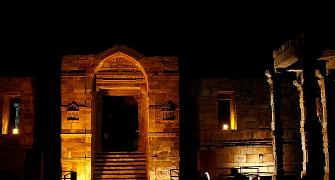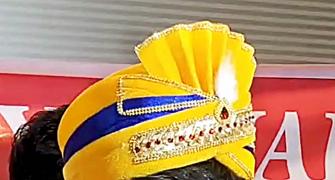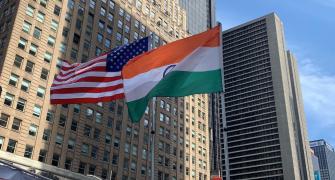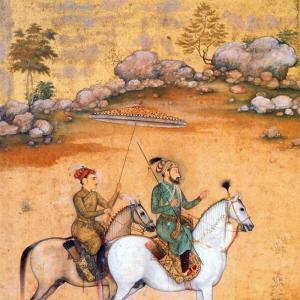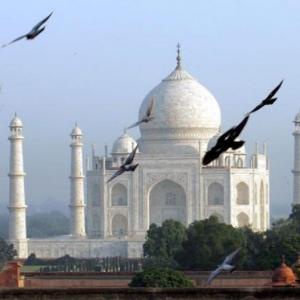'After it was finished, Shah Jahan visited the Taj only twice.'
'There is a letter from Aurangzeb to him after a visit, reporting that the dome was leaking and needed to be fixed.'
'Shah Jahan wasn't bothered: He had moved on to designing his next project, Shahjahanabad,' reveals Aakar Patel.
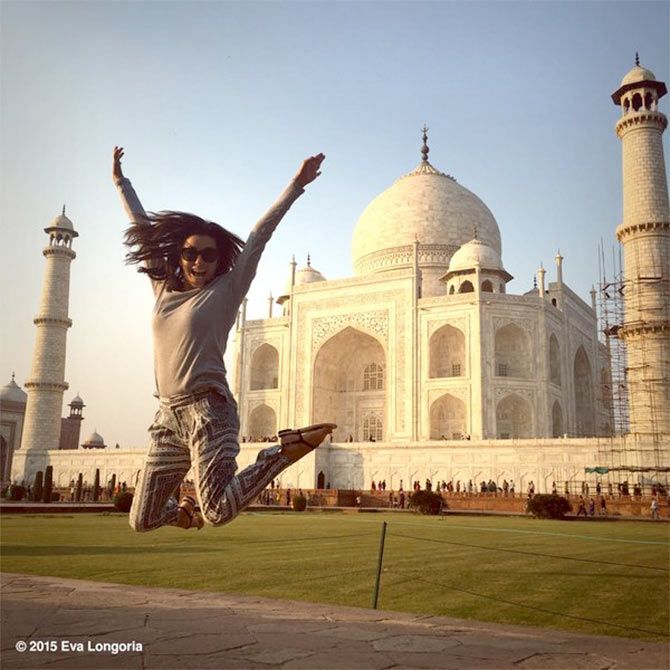
To what can we attribute the Uttar Pradesh government's decision to demote the Taj Mahal as a tourist attraction? Bigotry? Stupidity? Forgetfulness?
It is not easy to say, though given the atmosphere and the times we are living in, the answer is obvious. However, we should not be particularly concerned by this act of spitting at the sun from our Hindutva-minded friends.
The Taj needs no marketing and it is one of only three man-made structures that are instantly recognisable anywhere in the world, the other two being the Great Pyramid of Giza and the Eiffel Tower.
These are also the only three structures that the average human, whether Nigerian or New Zealander, can sketch from memory because their lines are clean and elegant and therefore memorable.
Anyone who has an idea of what goes into a building being designed from the bottom up will know what it took to make the Taj.
Shah Jahan is not my favourite Mughal and I will explain why in a bit as we take a look at some interesting aspects of our most famous dynasty. But he was without question the finest builder of any Indian ruler in history.
His major contributions are three. First, the peacock throne, which was actually a large room-sized structure that was dismantled when not being used. It was extraordinarily detailed (apparently there were bejewelled peacocks in the four corners).
What was looted by Nadir Shah was likely only the actual seat, which was but a single component of something grand in scale.
Second, the city of Shahjahanabad, which we know today as Old Delhi, with the Red Fort and the Jama Masjid, both classic buildings, and its organised street plan, possibly the first in India after the Indus Valley towns.
And third the Taj, which was actually his first project.
Shah Jahan absolutely nailed it, producing a perfect building admired by the entire world.
Mark Twain, who came to Agra on a package tour around the world, was moved enough by it to believe that the world was divided into those who had seen the Taj and those who hadn't.
In his work, Following the Equator, Twain also called it 'the most celebrated construction in the earth'.
Having seen it in the day and at night, he wrote: 'I knew all the time, that of its kind it was the wonder of the world, with no competitor now and no possible future competitor.'
The visitor today will be struck by how enormous the thing is, a truly magnificent monument.
Rabindranath Tagore called it, because it was constructed in grief for a beloved wife (Mumtaz Mahal and Shah Jahan had 14 children), 'a teardrop on the cheek of time'. I suspect the real reason so much money was spent on a dead wife wasn't love but respect.
It may surprise the reader to know that after it was finished, Shah Jahan visited the Taj only twice.
There is a letter from Aurangzeb to him after a visit, reporting that the dome was leaking and needed to be fixed. Shah Jahan wasn't bothered: He had moved on to designing his next project, Shahjahanabad, shifting the Mughal capital from Agra.
It is for this reason that I find the story about the jailed and pining Shah Jahan begging for a room facing the Taj probably false.
But it is probably true that when Aurangzeb sent his father Dara Shikoh's head (actually served on a platter when Shah Jahan was dining), the old man fainted and his face crashed into the table, breaking his teeth.
Why was Aurangzeb so cruel? The question should be turned around. Why did Shah Jahan hate Aurangzeb so much? It is not easy to understand, but it is true.
From a very young age, before he was an adult, Aurangzeb was sent out by his father on impossible missions ('Go and reconquer our ancestral lands in Samarkand' and so on), while Dara Shikoh was mollycoddled in court.
Unfortunately, for both father and his favourite son, this mistreatment of Aurangzeb produced a hardened and experienced warrior.
Finally, after Akbar, the Mughals produced an emperor who could fight.
Though he faced the imperial Mughal armies, Aurangzeb destroyed the opponent with his smaller field army.
Aurangzeb followed through to kill all his brothers (a common occurrence in the Mughal dynasty) and went on to rule for half a century.
He has an undeserved reputation for being anti-Hindu and the facts show this to be so. Aurangzeb was as inclusive as his forebears and as inclusive as any ruler in India ever was.
Babur's generals were mostly Chagatai Turks and Mongols. Humayun, after his exile in Iran, brought with him Shia Persian administrators, and Akbar introduced Rajputs to the court as we know.
The Marathas were brought by Aurangzeb, as he campaigned in the Deccan. There are records of long negotiations, many lasting several years, over the terms on which Maratha chieftains would enter Mughal service.
Shah Jahan was a useless warrior, like Humayun (whose main interest in armies was the colours of their uniform, which he changed each day of the week) and Jahangir (who was notoriously indolent and was once kidnapped by one of his own courtiers).
Shah Jahan became emperor because of his wife. Her relatives used the uncertainty around Jahangir's illness and death, to secure power for him.
By the time he arrived in Agra, his brothers had all been blinded.
This left the throne open for Khurram (as Shah Jahan was named) and without his wife, he would not have been emperor.
Towards the end of his life, Jahangir hated Khurram and writes of his son with total contempt in his memoirs.
Absent the quick actions of his wife, Khurram would likely have been blinded or executed by one of his brothers, instead of going on to become a name famous in history.
And so the Taj was likely an act of Shah Jahan showing gratitude and it explains why, having done this, he moved on without a qualm.
The Taj is the centrepiece of the Delhi-Agra-Jaipur triangle that pulls in hundreds of thousands of tourists into UP.
It is ingratitude bordering on stupidity that one would choose, for petty and juvenile reasons, to demote an asset any other nation would value and treasure.
IMAGE: Hollywood actress Eva Longoria at the Taj Mahal, December 2015. She captioned the picture, 'Can't leave Agra without a jumping photo in front of Taj Mahal.' Photograph: Kind courtesy Eva Longoria/Instagram



